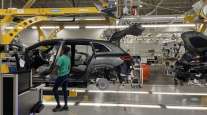Contributing Writer
Trucking Explores Augmented Reality to Enhance Training, Operations
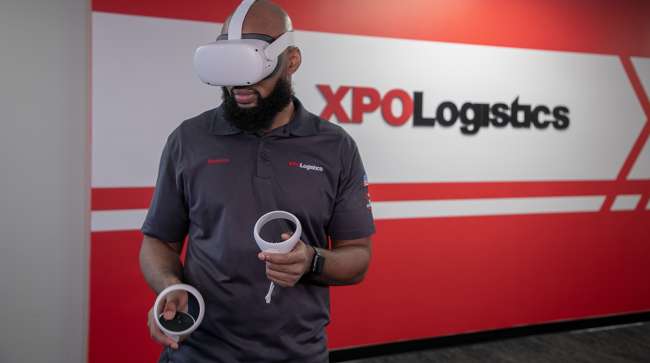
[Stay on top of transportation news: Get TTNews in your inbox.]
The adoption of immersive technologies such as augmented reality and virtual reality by the freight and logistics industry has accelerated amid the COVID-19 pandemic.
Although still in its early stages, organizations across the supply chain, including truck maker Daimler Trucks North America, transportation provider XPO Logistics and package delivery giants DHL and UPS, are beginning to utilize VR and AR for training, operations, marketing and servicing equipment.
Many companies explored ways to implement these technologies prior to the pandemic, but ramped up those efforts as the public health crisis reduced human contact and business travel. They have found that it can fill communication gaps that exist with videoconferencing and streaming applications.

Chaaya
“We tried testing Zoom and FaceTime at the start of the pandemic but quickly learned that a service technician couldn’t hold the phone or tablet with one hand and work on the truck with the other,” said Daoud Chaaya, DTNA’s director of field service.
UPS, meanwhile, has created a five-person immersive technology group to develop uses and guide the company’s business units to the best applications and hardware, said Jon Bowers, the company’s director of learning technology.
Although it is common for people to refer to immersive technology as virtual reality, it encompasses multiple applications, said Matt Johnston, division head of commercial solutions for Design Interactive, which incorporates augmented reality into its vehicle maintenance training solutions.
Augmented reality typically involves using a display such as a smartphone screen or a headset to view digital information overlaid on what you see in the real world. It could be 3D models, graphics and digital information.
“AR is digital information that is displayed in your world,” Johnston said.
XPO Logistics uses the technology to display diagrams and other information to guide workers in collecting goods in its warehouses.
“When you look at the bin where the product is, you can validate that you are picking the correct object,” said Mario Harik, XPO’s chief information officer.

Wolski
DHL uses a similar system in its warehouses and has found that it increases efficiency and reduces errors, said Megan Wolski, the company’s innovation engagement manager.
A pilot program at DTNA is using augmented reality to train service technicians at dealers near its Portland, Ore., headquarters.
“You can guide them step by step through the repair process that needs to take place,” Chaaya said.
He believes immersive technology will play a vital role in training and recruiting a new generation of service technicians who have an intuitive understanding of such systems developed from playing video games.
DTNA is looking at the technology’s potential to help drive more repair times under the 24-hour mark and slash training time for technicians.
Augmented reality also can enhance group training.
In Design Interactive’s Classroom XR system, a meeting leader or training instructor wears a Microsoft HoloLens 2 headset. The attendees streaming the meeting through a phone or computer will see what the leader is looking at, both an actual object, such as a truck tire, and the overlaid digital information. The leader can then scroll through multiple wear patterns on a digitized tire, comparing them to the physical tire, as a training exercise.
“They see lots of examples of what is normal and what is bad and would need to be removed from the vehicle,” Johnson said.
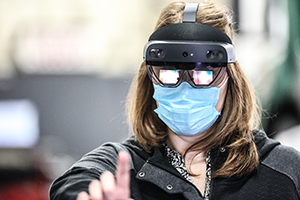
A DTNA worker uses an augmented reality headset. (Daimler Trucks North America)
Such a system represents how a company can dip its toes into immersive technology, Johnston said. It requires only one headset because the rest of the participants watch via video stream. Each HoloLens 2 costs $3,500.
Virtual reality, the other leg of immersive technology, is a more intensive approach because it completely removes the individual from the real world. Participants are encased in a headset and see and hear a completely digitized world.
UPS is using virtual reality to train drivers how to recognize safety hazards.
“The VR puts them in a city scene and has different levels that they work through as a driver. It is like a game,” Bowers said.
The program introduces various road hazards and asks the driver to identify the threats and react to avoid a collision.
More Q2 iTECH
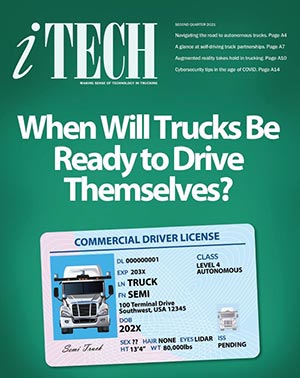
“They use the VR, and then later in the day, they drive a vehicle with an instructor and demonstrate the skills they have learned,” Bowers said.
Both XPO and DHL are using virtual reality to train warehouse workers.
“We have ‘gamified’ training so that they can learn how to use our system without risking someone’s freight,” DHL’s Wolski said.
It is used to train workers how to properly load airplane containers, operate forklifts and other functions, she said.
XPO is using its software with Oculus for Business headsets and is pleased with the results.
“The first thing we saw was that trainees had higher learning retention using VR,” Harik said. “And now we have seen higher productivity, lower waste and fewer errors in cross-dock and driver operations.”
The VR training improves knowledge retention because it involves a repeatable 3D experience while also reducing the time it takes to train workers to reach target productivity levels, he said.
XPO also uses virtual reality as a marketing tool by digitally placing customers and potential clients in a warehouse to demonstrate its deployment of automation and robotics.
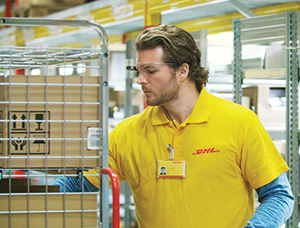
DHL says augmented reality has increased efficiency and reduced errors in its warehouses. (DHL)
DHL sees virtual reality as an eventual tool for testing changes in its operations without interrupting business.
“You could reimagine a warehouse digitally, move racking or change something but not have to do it in real life and mess up operations,” Wolski said.
All of this is rapidly becoming easier to do.
“One of the barriers several years ago was the hardware. It required a significant PC and expensive headset and base stations that track your movement,” UPS’ Bowers said. “Fast-forward to today, and we are using stand-alone headsets that you can throw in a backpack. Our application will run on those headsets and that makes it mobile.”
The cost of immersive technology has declined significantly in recent years.
“It now takes six to nine months to build the experience,” XPO’s Harik said. “That is a one-time cost. The headsets are not very expensive.”
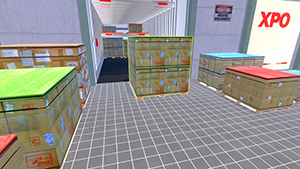
XPO is applying augmented reality in its warehouses to help guide workers. (XPO Logistics)
Some of the Oculus headsets cost about the same as a video game console.
“The cost component is not a big factor. The big factor is the benefits you get,” Harik said.
Companies are looking at ways to make greater use of the technology and anticipate that significant synergies can be leveraged across a company’s operations.
A truck builder such as DTNA, for example, could build a complete digital rendering of a tractor, including the cab, chassis and drivetrain, Chaaya said.
Once the virtual truck is built, the sales department could use it for VR presentations with customers, guiding them through changing cab configurations, adding options and playing with other features.
“You could show what it looks like to build with a specific seat or certain dash model,” he said.
Customers could even take a virtual look under the hood to examine the engine compartment and evaluate the ease of servicing.
At the same time, engineers could use the digital rendering to experiment with different designs, diagnose problems and train service technicians.
Bowers said the experience companies have had with the pandemic will push them to adopt more immersive technology.
“When you can’t have people next to each other, the next best thing is to immerse them digitally in the environment,” he said. “That concept will speed up the development and use of the technology across many industries, including transportation.”
UPS Inc. ranks No. 1 on the Transport Topics Top 100 list of the largest for-hire carriers in North America. XPO Logisics ranks No. 3. XPO also ranks No 1 on the TT Top 50 list of largest logistics companies in North America. UPS Supply chain Solutions ranks No 2. DHL Supply Chain ranks No. 3.
Want more news? Listen to today's daily briefing below or go here for more info:


